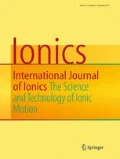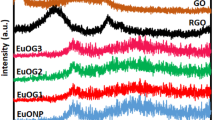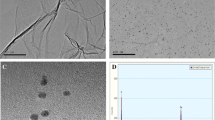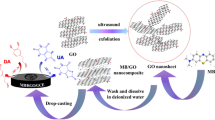Abstract
In this article, we constructed an electrochemical sensor for highly sensitive determination of β-nicotinamide adenine dinucleotide (NADH) using the poly(diallyldimethylammonium chloride)-functionalized reduced graphene oxide nanocomposite modified electrode (PDDA-rGO/GCE). The nanocomposite was characterized by transmission electron microscopy, Fourier transform-infrared spectrometry, ultraviolet-visible absorption spectrometry, cyclic voltammetry, and electrochemical impedance spectroscopy. The experimental results demonstrated that the fabricated sensor exhibited excellent electrocatalytic activity on the oxidation of NADH with a decreased about 200 mV in overpotential and 5.0-fold increment in the oxidation peak current compared to a bare GCE. Applying cyclic voltammetry, a wide linear range from 1.0 × 10−7 to 2.9 × 10−3 M with low limit of detection (LOD) of 3.4 × 10−8 M and high sensitivity of 463.3 μA mM−1 cm−2 were obtained, which was superior to other NADH electrochemical sensors reported previously. Furthermore, the fabricated NADH sensor possessed excellent selectivity, reproducibility, and stability. The oxidation mechanism of NADH at the PDDA-rGO/GCE was also discussed in detail.

A simple NADH sensing platform based on PDDA-rGO composite is constructed, which exhibits an ultra-low detection limit ( 3.4×10-8 M) towards the oxidation of NADH, and the electrochemical reaction mechanism of NADH is discussed in detail.





Similar content being viewed by others
References
Ali I, Khan T, Omanovic S (2014) Direct electrochemical regeneration of the cofactor NADH on bare Ti, Ni, Co and Cd electrodes: the influence of electrode potential and electrode material. J Mol Catal A Chem 387:86–91
Chang HC, Wu XJ, Wu CY, Chen Y, Jiang H, Wang XM (2011) Catalytic oxidation and determination of β-NADH using self-assembly hybrid of gold nanoparticles and graphene. Analyst 136:2735–2740
Moradi R, Sebt SA, Karimi-Maleh H, Sadeghi R, Karimi F, Bahari A, Arabi H (2013) Synthesis and application of FePt/CNTs nanocomposite as a sensor and novel amide ligand as a mediator for simultaneous determination of glutathione, nicotinamide adenine dinucleotide and tryptophan. Phys Chem Chem Phys 15:5888–5897
Wu LN, Zhang XJ, Ju HX (2007) Detection of NADH and ethanol based on catalytic activity of soluble carbon nanofiber with low overpotential. Anal Chem 79:453–458
Yu QR, Heikal AA (2009) Two-photon autofluorescence dynamics imaging reveals sensitivity of intracellular NADH concentration and conformation to cell physiology at the single-cell level. J Photochem Photobiol B 95:46–57
Vrecko K, Storga D, Birkmayer JGD, Reinhard M, Tafeit E, Horejsi R, Reibnegger G (1997) NADH stimulates endogenous dopamine biosynthesis by enhancing the recycling of tetrahydrobiopterin in rat phaeochromocytoma cells. Biochim Biophys Acta (BBA) Mol Basis Dis 1361:59–65
Alano CC, Ying WH, Swanson RA (2004) Poly(ADP-ribose) polymerase-1-mediated cell death in astrocytes requires NAD+ depletion and mitochondrial permeability transition. J Biol Chem 279:18895–18902
Ying WH (2007) NAD+/NADH and NADP+/NADPH in cellular functions and cell death: regulation and biological consequences. Antioxid Redox Signal 10:179–206
Kasimova MR, Grigiene J, Krab K, Hagedorn PH, Flyvbjerg H, Andersen PE, Møller LM (2006) The free NADH concentration is kept constant in plant mitochondria under different metabolic conditions. Plant Cell 18:688–698
Yates SP, Merrill AR (2005) Characterization of oxidized nicotinamide adenine dinucleotide (NAD+) analogues using a high-pressure-liquid-chromatography-based NAD+-glycohydrolase assay and comparison with fluorescence-based measurements. Anal Biochem 340:41–51
Bernofsky C, Swan M (1973) An improved cycling assay for nicotinamide adenine dinucleotide. Anal Biochem 53:452–458
Renault G, Raynal E, Sinet M, Berthier JP, Godard B, Cornillault J (1982) A laser fluorimeter for direct cardiac metabolism investigation. Opt Laser Technol 14:143–148
Li JP, Li SH, Yang CF (2012) Electrochemical biosensors for cancer biomarker detection. Electroanalysis 24:2213–2229
Wang ZH, Xiao SF, Chen Y (2005) Electrocatalytic and analytical response of β-cyclodextrin incorporated carbon nanotubes-modified electrodes toward guanine. Electroanalysis 17:2057–2061
Moiroux J, Elving PJ, Chem A (1978) Effects of adsorption, electrode material, and operational variables on the oxidation of dihydronicotinamide adenine dinucleotide at carbon electrodes. Anal Chem 50:1056–1062
Samec Z, Elving PJ (1983) Anodic oxidation of dihydronicotinamide adenine dinucleotide at solid electrodes; mediation by surface species. J Electroanal Chem 144:217–234
Muhammad S, Mazen KN, Muhammad M, Abdulnaser A, Shehzada M, Chanbasha B (2016) Chemically modified electrodes for electrochemical detection of dopamine in the presence of uric acid and ascorbic acid: a review. Trends Anal Chem 76:15–29
Ge B, Tan YM, Xie QJ, Ma M, Yao SZ (2009) Preparation of chitosan-dopamine-multiwalled carbon nanotubes nanocomposite for electrocatalytic oxidation and sensitive electroanalysis of NADH. Sensors Actuators B Chem 137:547–554
Zhu JE, Chen X, Yang WS (2010) A high performance electrochemical sensor for NADH based on graphite nanosheet modified electrode. Sensors Actuators B Chem 150:564–568
Wang ZH, Liang QL, Wang YM, Luo GA (2003) Carbon nanotubes-intercalated graphite electrodes for simultaneous determination of dopamine and serotonin in the presence of ascorbic acid. J Electroanal Chem 540:129–134
You CP, Yan XW, Wang Y, Zhang S, Kong JL, Zhao DY, Liu BH (2009) Electrocatalytic oxidation of NADH based on bicontinuous gyroidal mesoporous carbon with low overpotential. Electrochem Commun 11:227–230
Novoselov KS, Geim AK, Morozov SV, Jiang D, Katsnelson MI, Grigorieva IV, Dubonos SV, Firsov AA (2005) Two-dimensional gas of massless dirac fermions in graphene. Nature 438:197–200
Tung VC, Allen MJ, Yang Y, Kaner RB (2009) High-throughput solution processing of large-scale graphene. Nat Nanotechnol 4:25–29
Liu WL, Zhang JF, Li C, Tang L, Zhang ZQ, Yang M (2013) A novel composite film derived from cysteic acid and PDDA-functionalized graphene: enhanced sensing material for electrochemical determination of metronidazole. Talanta 104:204–211
Wang ZH, Shi GY, Zhang FF, Xia JF, Gui RJ, Yang M, Bi S, Xia L, Li YH, Xia LH, Xia YZ (2015) Amphoteric surfactant promoted three-dimensional assembly of graphene micro/nanoclusters to accomodate Pt nanoparticles for methanol oxidation. Electrochim Acta 160:288–295
Zhang S, Shao YY, Liao HG, Engelhard MH, Yin GP, Lin YH (2011) Polyelectrolyte-induced reduction of exfoliated graphite oxide: a facile route to synthesis of soluble graphene nanosheets. ACS Nano 5:1785–1791
Le ZG, Liu ZR, Qian Y, Wang CY (2012) A facile and efficient approach to decoration of graphene nanosheets with gold nanoparticles. Appl Surf Sci 258:5348–5353
Fu L, Zheng YH, Wang AW (2015) Poly (diallyldimethylammonium chloride) functionalized reduced graphene oxide based electrochemical sensing platform for luteolin determination. Int J Electrochem Sci 10:3518–3529
Hummers WJ, Offeman RE (1958) Preparation of graphitic oxide. J Am Chem Soc 80:442
Schniepp HC, Li J-L, McAllister MJ, Sai H, Herrera-Alonso M, Adamson DH, Prud’homme RK, Car R, Saville DA, Aksay IA (2006) Functionalized single graphene sheets derived from splitting graphite oxide. J Phys Chem B 110:8535–8539
Zhang JL, Yang HJ, Shen GX, Cheng P, Zhang JY, Guo SW (2010) Reduction of graphene oxide via L-ascorbic acid. Chem Commun 46:1112–1114
Miao DD, Li JJ, Yang R, Qu JJ, Qu LB, Harrington PB (2014) Supersensitive electrochemical sensor for the fast determination of rutin in pharmaceuticals and biological samples based on poly (diallyldimethylammonium chloride)-functionalized graphene. J Electroanal Chem 732:17–24
Liu LJ, Gao X, Zhang P, Feng SL, Hu FD, Li YD, Wang CM (2014) Ultrasensitive detection of ferulic acid using poly(diallyldimethylammonium chloride) functionalized graphene-based electrochemical sensor. J Anal Methods Chem 2014:1–9
Dey RS, Hajra S, Sahu RK, Raj CR, Panigrahi MK (2012) A rapid room temperature chemical route for the synthesis of graphene: metal-mediated reduction of graphene oxide. Chem Commun 48:1787–1789
Anson FC (1964) Application of potentiostatic current integration to the study of the adsorption of cobalt(III)-(ethylenedinitrilo(tetraacetate) on mercury electrodes. Anal Chem 36:932–934
Shao Y, Mirkin MV, Fish G, Kokotov S, Palanker D, Lewis A (1997) Nanometer-sized electrochemical sensors. Anal Chem 69:1627–1634
Radoi A, Compagnone D (2009) Recent advances in NADH electrochemical sensing design. Bioelectrochemistry 76:126–134
Rajaram R, Anandhakumar S, Mathiyarasu J (2015) Electrocatalytic oxidation of NADH at low overpotential using nanoporous poly(3,4)-ethylenedioxythiophene modified glassy carbon electrode. J Electroanal Chem 746:75–81
Zhu XL, Yuri I, Gan X, Suzuki I, Li GX (2007) Electrochemical study of the effect of nano-zinc oxide on microperoxidase and its application to more sensitive hydrogen peroxide biosensor preparation. Biosens Bioelectron 22:1600–1604
Sharifi E, Salimi A, Shams E (2013) Electrocatalytic activity of nickel oxide nanoparticles as mediatorless system for NADH and ethanol sensing at physiological pH solution. Biosens Bioelectron 45:260–266
Zhang YF, Bo XJ, Nsabimana A, Luhana C, Wang G, Wang H, Li M, Guo LP (2014) Fabrication of 2D ordered mesoporous carbon nitride and its use as electrochemical sensing platform for H2O2, nitrobenzene, and NADH detection. Biosens Bioelectron 53:250–256
Chen CH, Chen YC, Lin MS (2013) Amperometric determination of NADH with Co3O4 nanosheet modifiedelectrode. Biosens Bioelectron 42:379–384
Shalini J, Sankaran KJ, Chen H-C, Lee C-Y, Tai N-H, Lin IN (2014) Mediatorless N2 incorporated diamond nanowire electrode for selective detection of NADH at stable low oxidation potential. Analyst 139:778–785
Aydoğdu G, Zeybek D, Zeybek B, Pekyardımcı Ş (2013) Electrochemical sensing of NADH on NiO nanoparticles-modified carbon paste electrode and fabrication of ethanol dehydrogenase-based biosensor. J Appl Electrochem 43:523–531
García-Pineda I, Mayén M, Rodríguez-Mellado JM, Rodríguez-Amaro R (2013) NADH electrocatalytic oxidation on gold nanoparticle-modified PVC/TTF-TCNQ composite electrode application as amperometric sensor. Electroanalysis 25:1981–1987
Li L, Lu HM, Deng L (2013) A sensitive NADH and ethanol biosensor based on graphene-Au nanorods nanocomposites. Talanta 113:1–6
Dilgin Y, Kızılkay B, Dilgin DG, Gokcel H, Gorton L (2013) Electrocatalytic oxidation of NADH using a pencil graphite electrode modified with quercetin. Colloid Surf B 102:816–821
Maroneze CM, Arenas LT, Luza Rita CS, Benvenutti EV, Landers R, Gushikem Y (2008) Meldola blue immobilized on a new SiO2/TiO2/graphite composite for electrocatalytic oxidation of NADH. Electrochim Acta 53:4167–4175
Ferreira GM, Oliveira FM, Leite FR, Maroneze CM, Kubota LT, Damos FS, Luz RC (2013) DNA and graphene as a new efficient platform for entrapment of methylene blue (MB): studies of the electrocatalytic oxidation of β-nicotinamide adenine dinucleotide. Electrochim Acta 111:543–551
Liang YY, Wu DQ, Feng XL, Müllen K (2009) Dispersion of graphene sheets in organic solvent supported by ionic interactions. Adv Mater 21:1679–1683
Fan Y, Yang X, Yang CP, Liu JH (2012) Au-TiO2/graphene nanocomposite film for electrochemical sensing of hydrogen peroxide and NADH. Electroanalysis 24:1334–1339
Acknowledgments
This work was supported by the National Natural Science Foundation of China (Nos. 21565021 and 21245004).
Author information
Authors and Affiliations
Corresponding author
Electronic supplementary material
ESM 1
The study of NADH sensor at different scan rates, the optimization of experimental variables, and the study of reproducibility and stability of the modified electrode. (DOC 4478 kb)
Rights and permissions
About this article
Cite this article
Lu, J., Liu, Y., Liu, X. et al. Construction of a highly sensitive NADH sensing platform based on PDDA-rGO nanocomposite modified electrode. Ionics 22, 2225–2233 (2016). https://doi.org/10.1007/s11581-016-1753-7
Received:
Revised:
Accepted:
Published:
Issue Date:
DOI: https://doi.org/10.1007/s11581-016-1753-7




